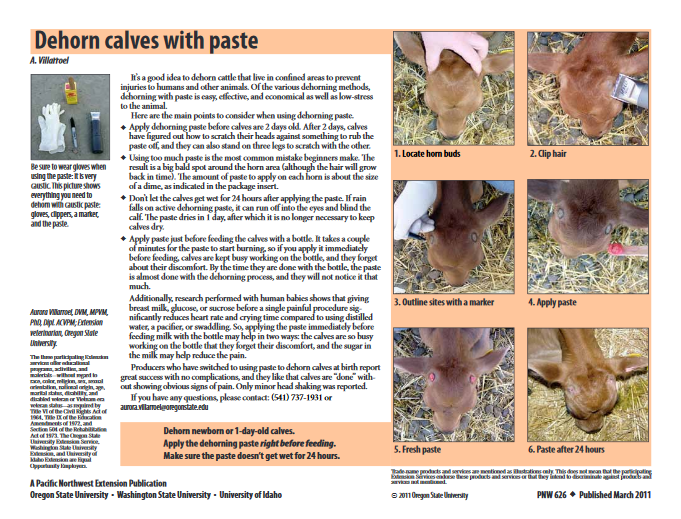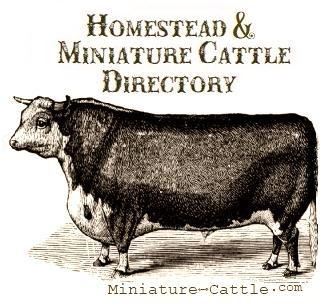Horned, Polled & Scurred Cattle
The polled trait is an old DNA mutation that is dominant over the original ("wild type") horned cattle. There are genetic tests for today's two common polled mutations--the Celtic and Friesian variants. The inheritance of polledness (the absence of horns) is somewhat complicated. Plus, there are polled variants that have not been isolated yet (so, those would have no DNA tests). The type of gene action for polledness varies considerably between and among species. Polled domesticated cattle have been documented in history as far back as 8000 years ago, with some of the earliest evidence found in today's Slovakia and Germany regions. The known polled variants and the year they were identified as separate variants are:
-
2012: Polled, Celtic allele (PC/h) [beef breeds of Celtic and European origin] (Galloway, Angus, Blonde d’Aquitaine, Charolais, Dexter, Hereford, Limousin, Shorthorn, Simmental). The presence or absence of horns in the Celtic mutation can be attributed to the action of two alleles at an autosomal locus.
-
2013: Polled, Friesian allele (PF/h) [Holstein Friesian influenced dairy breeds] (Holstein-Friesian, Jersey). The presence or absence of horns in the Friesian mutation can also be attributed to the action of two alleles at an autosomal locus.
-
2017: Polled, Mongolian allele [Mongolian Turano]. Turano-Mongolian cattle are a group of taurine cattle found in Northern and Eastern Asia. They are morphologically and genetically distinct from the Near Eastern group of taurine cattle (from which European cattle are descended) and may have been domesticated independently. There is no test for this variant.
-
2019: Polled, Guarani Bos indicus allele (PG/h) [Nellore] Zebu breeds may have a different inheritance pattern or mutation for the polled trait. However, some Brahman (a distinctly American breed), have tested positive for the Celtic polled variant (which makes sense knowing the history of their breed development). Research is ongoing.
-
Modern polled variants have been created artificially to produce genetically modifed (GMO) polled cattle.
Scurred: Inheritance of scurs is not completely understood, but here is what we believe so far: Scurs are horn-like tissue attached to the skin, not to the skull as with horns. Scurs can be anywhere from very small to the size of small horns. The scur gene is separate from the polled gene. Scurs (obviously) can only be seen in polled cattle. The presence of scurs indicates heterozygous polled (P/h) cattle (they carry 1 allele for horns). Scurs are suppressed in homozygous polled (PP) cattle. So, if you have a bull with scurs, he would be heterozygous polled, not homozygous polled. Scurs occur more frequently in males than in females. The theory is: scurs may be sex linked, and dominant in bulls. Scurs may be recessive in females. Cows may need to carry two copies of the scur allele to grow scurs; bulls may need only one copy to grow scurs. Research is still ongoing.
 Polled cattle are beneficial in herds from both an economic and animal welfare point of view. Bruising of other cattle and injuries to handlers due to horns is eliminated. The inhumane pain and trauma of dehorning is avoided. In horned breeds, if dehorned cattle are preferred, paste de-budding baby calves is the best option. Paste dehorning new calves is humane and does not cause stress to calves when performed in the first 48 hours of life. (Click to open pdf instructions in separate window How to Paste De-Bud Baby Calves.)
Polled cattle are beneficial in herds from both an economic and animal welfare point of view. Bruising of other cattle and injuries to handlers due to horns is eliminated. The inhumane pain and trauma of dehorning is avoided. In horned breeds, if dehorned cattle are preferred, paste de-budding baby calves is the best option. Paste dehorning new calves is humane and does not cause stress to calves when performed in the first 48 hours of life. (Click to open pdf instructions in separate window How to Paste De-Bud Baby Calves.)
![]()
Sources & Resources
![]()
Understanding the effects of the bovine POLLED variants
J E Aldersey, T S Sonstegard, J L Williams, C D K Bottema;
Animal Genetics 2020 January 30. Horns are paired appendages on the head of bovine species, comprising an inner bony core and outer keratin sheath. The horn bud forms during early fetal development but ossification of the developing horn does not occur until approximately 1 month after birth. Little is known about the genetic pathways that lead to horn growth. Hornless, or polled, animals are found in all domestic bovids. Histological studies of bovine fetuses have shown that the horn bud does not form in polled individuals. There are currently four known genetic variants for polledness in cattle on BTA1. All of the variants are intergenic, but probably affect regulation of nearby genes or long non-coding RNAs. Transcriptomic studies suggest that the expression of two nearby long non-coding RNAs are affected by the Celtic POLLED variant, but further studies are required to confirm these data. Candidate genes located elsewhere in the genome are involved in regulating bone formation and epithelial-to-mesenchymal transition. Expression of one of these candidate genes, RXFP2, appears to be reduced in the fetal horn bud of polled animals carrying the Celtic variant compared with horned individuals. Investigating horn ontogenesis and the genetic pathway by which the POLLED variants prevent horn development has implications for cattle breeding. If the genetic basis of horn bud formation and polledness is better understood, then new targets may be identified for precision genome editing to create polled individuals.
Polledness in Argentinean Creole cattle, five centuries surviving
A H Falomir-Lockhart, M F Ortega Masague, G Rudd Garces, M E Zappa, P Peral García, H F Morales, F D Holgado, A Rogberg Muñoz, G Giovambattista;
Animal Genetics 2019 June 10.
Polledness has been shown to have autosomal Mendelian inheritance, with the polled locus being dominant to the horned locus. This trait was mapped to the BTA1 centromeric end in several breeds. One of the distinctive attributes of Creole cattle, such as the Argentinean Creole, is the presence of long, lyre-shaped horns. However, polled native animals were reported before the introduction of modern selected European breeds. Here, we studied the origin of the polled mutation, either independent or introgressed, in a Creole line from the Creole cattle founder group at the IIACS-INTA Leales Experimental Station (northwest Argentina). The study sample (65 animals: 26 horned and 39 polled) was genotyped using high-density SNP microarrays and three previously reported genetic markers (P202 ID , P80kb ID and PG ). A genome-wide association study, selection signatures, linkage disequilibrium analysis and copy number variations were used to detect the responsible region and the segregating haplotypes/alleles. The interval mapped in the Leales herd (1.23-2.13 Mb) overlapped with the region previously reported in several European cattle breeds, suggesting that the same locus could be segregating in this population. The previously reported variants PF and PG were not detected, thus dismissing the Holstein-Friesian and Nellore origins of the polled phenotype in this native breed. Conversely, the presence of the Celtic variant PC suggests an almost complete co-segregation. The cluster analysis rejected the hypothesis of recent introgression, which is compatible with the historical record of polled Creole cattle in northwest Argentina..
The genetics of Horned, Polled & Scurred Cattle Texax A&M University
Understanding Horned/Polled and Scurred Traits
Hereford.org
Polled (2015 research report)
![]()
Homestead & Miniature Cattle Directory
![]()
Homestead Cattle Association
![]()
Homestead & Miniature Cattle Registry
Heritage Cattle Registry
![]()
©published online 2019
